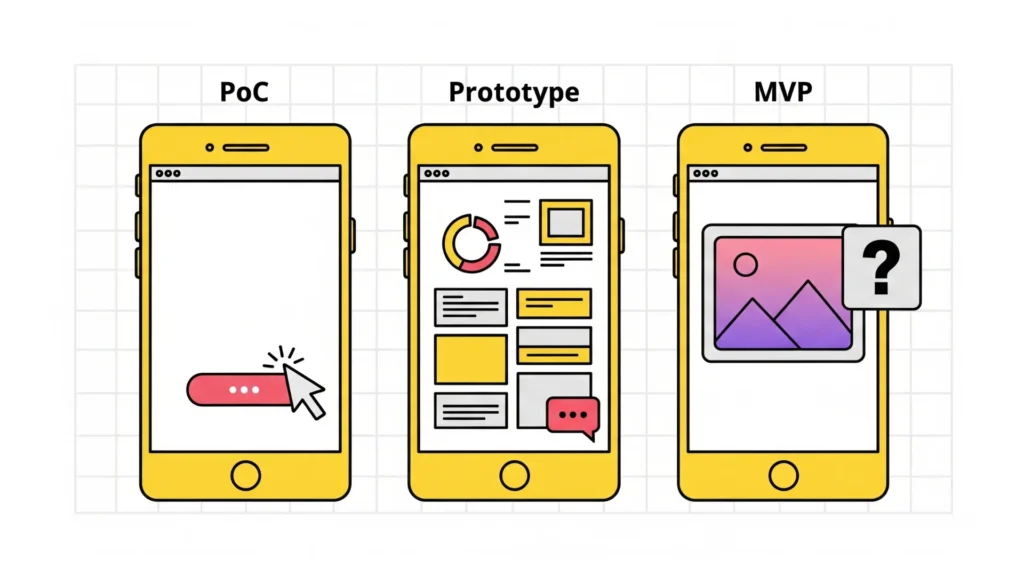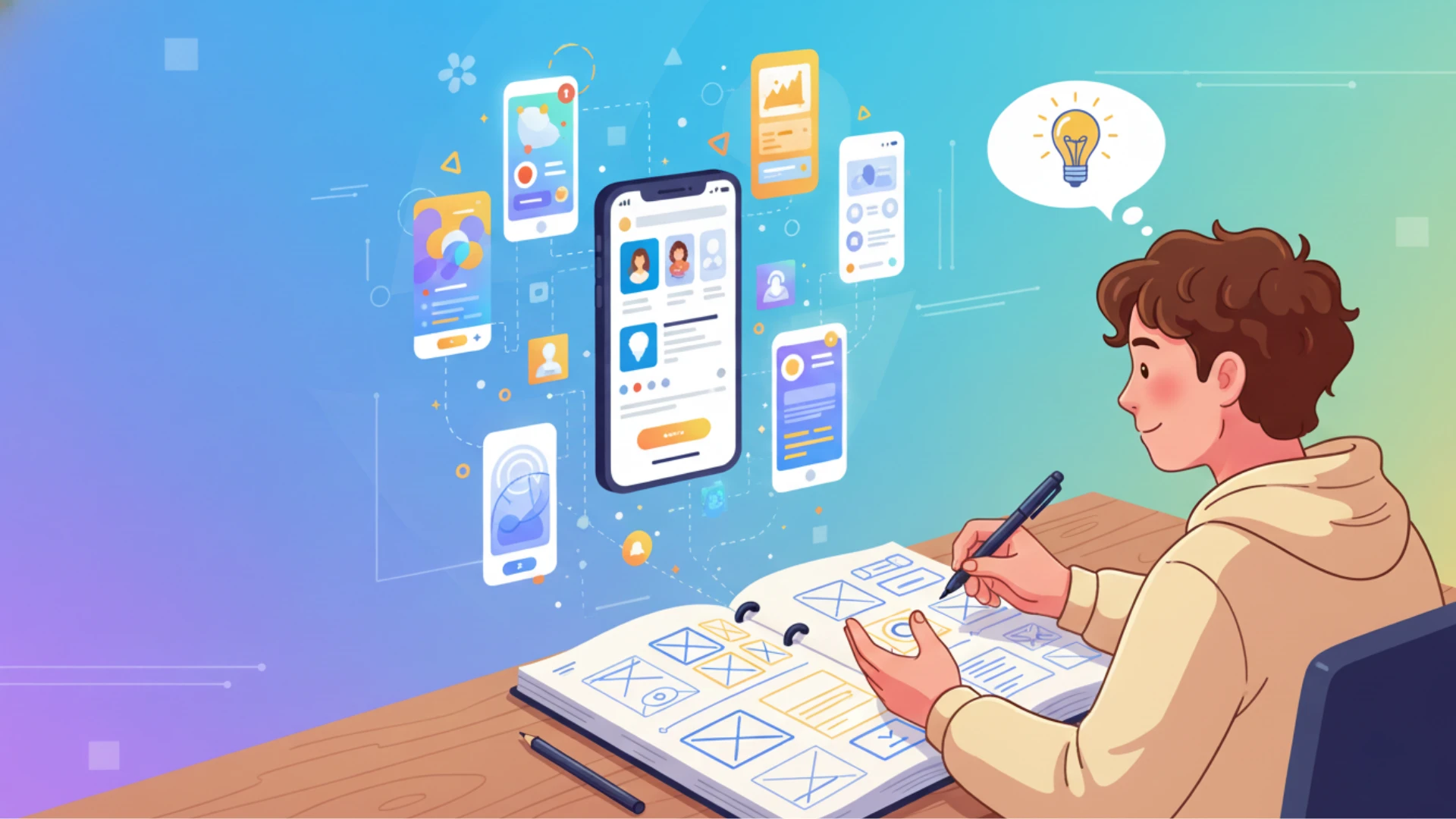In product development, clarity is critical. Too often, teams confuse a Proof of Concept (PoC), a prototype, and a Minimum Viable Product (MVP), treating them as interchangeable stages of development.
In reality, each serves a distinct purpose. Misunderstanding these differences can waste resources, delay launches, or weaken investor confidence.
This guide breaks down PoC vs prototype vs MVP in detail.
Whether you’re validating an idea, testing user flows, or launching early to market, understanding these distinctions is the foundation of a successful MVP development process.
Introduction to PoC, Prototype, and MVP

Definitions and Core Purposes
- Proof of Concept (PoC): A PoC demonstrates whether an idea or technology is technically feasible.
It answers: Can this be built?
- Prototype: A prototype visualizes the product experience. It explores workflows, design, and usability without requiring a fully functional backend.
It answers: How will we build it? / How is this going to work?
- Minimum Viable Product (MVP): An MVP delivers core functionality that solves a real user problem. It’s the leanest version of your product that can be launched to market for early validation.
It answers: How will my target users respond to my product? / Will it really solve their problems?
Each stage reduces uncertainty differently. PoCs validate feasibility, prototypes validate design, and MVPs validate market demand.
Why Understanding the Differences Matters in 2025
Today, startups must validate ideas quickly and efficiently.
Confusing one stage with another will only lead to poor decisions, such as investing heavily in prototypes that never validate demand, or skipping a PoC and discovering technical limitations too late.
However, by knowing a clear difference while talking PoC vs Prototype vs MVP, founders can allocate resources wisely, win investor trust earlier, and align development efforts with long-term strategy.
This clarity also supports smoother transitions from idea to launch, making it easier to leverage MVP development for scaling.
7 Key Differences Between PoC, Prototype, and MVP
The distinctions between these three approaches become clearer when viewed across seven dimensions:
| Criteria | PoC (Proof of Concept) | Prototype | MVP (Minimum Viable Product) |
| 1. Purpose and Goals | Validate technical feasibility and prove if an idea or technology can be built. | Visualize and test design, workflows, and usability. | Deliver a functional product with core features to validate market demand. |
| 2. Development Stage and Timeline | Earliest stage; short cycles focused on feasibility (weeks). | Pre-MVP design phase; built during short design sprints. | Later stage: multi-sprint build followed by real user testing and iteration. |
| 3. Level of Functionality and Interactivity | Minimal functionality; often non-interactive technical demonstration. | Interactive but not production-ready; focuses on design validation. | Functional and shippable with essential features; production-ready for early adopters. |
| 4. Target Audience for Each Approach | Internal teams, stakeholders, or investors validating feasibility. | Designers, product managers, and early testers evaluating usability. | Real users and customers validating product-market fit. |
| 5. Investment Required and Resource Involvement | Low investment; small technical team only. | Moderate investment; requires designers and some dev input. | Higher investment; a cross-functional team is needed with design, dev, QA, and product. |
| 6. Risks Addressed and Validation Focus | Addresses technical risks – can it be built? | Addresses design risks – how will it work for users? | Addresses market risks – will users adopt and pay? |
| 7. Outcome and Use Cases | Clear answer on feasibility; informs go/no-go decision. | Insights into usability issues and design refinements. | Evidence of demand, traction, and foundation for scaling. |
When to Use PoC, Prototype, and MVP in Your Product Journey
You don’t pick between PoC, prototype, and MVP at random. You choose based on what risk you’re trying to reduce right now: technical, usability, or market.
That’s the cleanest way to organize your roadmap across the product development stages and keep the poc vs prototype vs MVP comparison practical.
Ideal Scenarios for PoC
Use a PoC when you must de-risk feasibility before design or go-to-market.
Common triggers:
- Novel technology or integration risk: new algorithm, hardware, API, or compliance barrier you’ve never shipped before.
- Data dependencies: you need to prove a model can hit a baseline with your data volume/quality.
- Regulatory or security constraints: healthcare, fintech, or governmental organization; prove it can be built safely first.
- Internal stakeholder buy-in: engineering leadership or investors want proof that the core idea is viable.
Cost drivers (what makes a PoC expensive or cheap):
- Depth of R&D (quick spike vs. foundational exploration).
- Data engineering (cleaning pipelines, anonymization).
- Tooling & infra (temporary cloud resources, vendor sandboxes).
- Specialist time (ML, embedded, security).
Typical timeline shape: short, focused tech spikes; think one or a few sprints, not a quarter-long build. Keep the scope narrow so you can answer one yes/no question decisively.
Deliverables you should expect:
- A working technical demonstration (doesn’t need UI polish).
- Evidence package: logs, benchmarks, constraints, and next-step recommendations.
- Feasibility risks mapped to mitigation options.
Go / No-Go criteria:
- Go: The core concept works under realistic constraints; risks and costs are acceptable.
- No-Go / Pivot: Results fail under realistic data or compliance; costs explode with scale.
Competitor alignment: PoC primarily validates feasibility and is often internal, while MVP targets market testing later.
Best Cases to Develop a Prototype
Use a prototype when you can de-risk usability and flow before code hardens.
Common triggers:
- Early product validation techniques: test information architecture, micro-copy, navigation, and conversion moments.
- Stakeholder & investor storytelling: show the experience clearly before committing engineering capacity.
- Design alternatives: compare flows A/B/C with users quickly.
What type of prototype fits:
- Low-fidelity (wireframes): align on flow fast; cheapest to iterate.
- High-fidelity (clickable UI): validate interaction details and visual language.
- Live-data prototype: wire a real API for one path to validate a risky interaction or performance assumption (still not production).
Cost drivers:
- Fidelity level (low-fi vs high-fi vs live-data).
- Screen count & variant exploration.
- UX research (recruiting, sessions, synthesis).
- Design-system readiness (reusable components speed everything up).
Timeline shape: fast design sprints; add time only if you’re running moderated tests or multiple variants.
Deliverables you should expect:
- Clickable prototype + annotated user flows.
- Usability findings: tasks passed/failed, friction points, language clarity.
- Prioritized change list feeding the MVP development process.
Go / No-Go criteria:
- Go: Users complete core tasks; top usability issues have clear fixes.
- Rework: Critical tasks fail, or the value prop isn’t understood, iterate prototype before code.
Competitor alignment: Prototype = limited functionality to test usability; it’s often external for feedback, unlike PoC.
When to Build and Launch an MVP
Build an MVP when you can de-risk market demand with real usage and revenue signals.
Common triggers:
- You’ve proven feasibility (PoC) and usability (prototype), and now need actual users and operational metrics.
- You’re aiming for product/market fit learning loops, not polish.
- You want to validate pricing, onboarding, and retention in production.
Scope principles for MVP:
- One core job-to-be-done completed end-to-end.
- Essential integrations only (payments, auth, data ingestion).
- Observability & testing baked in from day one (you’re learning from real traffic).
Cost drivers:
- Engineering breadth (backend, frontend, mobile, data).
- Integration count (payments, identity, external APIs).
- Security & compliance (SSO, audit logs, PII handling).
- SRE basics (stability, monitoring, rollback).
Timeline shape: multi-sprint build to a public or limited release, followed by rapid iteration cycles. Plan time for MVP testing techniques, usability, analytics, and qualitative feedback loops, because learning is the product at this stage.
If you’re preparing to scope your first release, here’s a detailed guide on building a minimum viable product step by step.
Deliverables you should expect:
- Shippable product with core features only.
- Analytics & dashboards for activation, retention, engagement, and core outcome metrics.
- Release plan + backlog prioritized by learning impact.
Go / No-Go criteria:
- Go (iterate/scale): Early cohorts activate and retain; unit economics trend positive with improvements.
- Pivot: Weak engagement or repeated failure on core value after targeted fixes.
Competitor alignment: MVP is a functional product for market testing with core features; more than a prototype, less than a full build.
Practical Decision Grid (Quick Read)
- Are you facing technical unknowns? → Start with PoC.
- You know it can be built, but not how it should feel or flow? → Build a prototype.
- You’re confident in feasibility & UX, and now need real users and revenue signals? → Ship an MVP.
Benefits and Limitations of Each Approach
Choosing between a PoC, prototype, or MVP isn’t about picking the “best” — it’s about selecting the right fit for the problem you’re solving at that stage. Each comes with its advantages and trade-offs.
Advantages of PoC, Prototypes, and MVPs
- PoC: Offers clarity on technical feasibility before significant investment. It reduces the risk of betting on unproven technologies.
- Prototype: Accelerates design validation, allowing teams to refine usability and user flows early. This leads to smoother development cycles later.
- MVP: Provides real-world feedback from actual users, helping validate market demand and uncover monetization opportunities sooner.
Common Pitfalls and How to Avoid Them
- PoC pitfalls: Teams sometimes over-engineer PoCs, turning them into mini-products. The fix? Keep PoCs tightly scoped to a single question.
- Prototype pitfalls: Mistaking a polished prototype for a near-final product can create false expectations. Communicate clearly that prototypes are for design feedback, not production.
- MVP pitfalls: Many teams overload MVPs with “nice-to-have” features. Instead, focus only on the core functionality tied to your primary value proposition.
After launch, you can refine based on structured MVP testing techniques that reveal how users interact with your core features
Best Practices for Aligning Product Development with Business Goals
The value of PoCs, prototypes, and MVPs multiplies when they’re aligned with broader business strategy rather than treated as isolated exercises.
- Tie deliverables to KPIs: A PoC should confirm feasibility tied to cost efficiency, a prototype should validate usability linked to engagement goals, and an MVP should be measured against adoption and retention.
- Stage-gate decisions: Use each stage as a formal checkpoint. Move from PoC → prototype → MVP only when clear criteria are met.
- Balance speed with learning: Don’t rush to an MVP just to ship faster. Every skipped step risks bigger costs later.
- Leverage early product validation techniques: Run usability testing during prototyping and structured feedback loops during MVP launch.
- Involve stakeholders early: Sharing prototypes or PoC results builds confidence with investors and executives, improving funding and resourcing decisions.
Conclusion
Navigating PoC vs prototype vs MVP requires understanding that each is a tool for a different kind of risk.
The best product teams in 2025 don’t see these stages as optional checkboxes but as a roadmap. Skipping them often leads to wasted spend, longer cycles, or failed launches.
For teams looking to accelerate this journey, explore our tailored MVP development services designed for startups and enterprises.
Working with the right MVP development company, like American Chase, ensures you avoid common pitfalls and align every stage with long-term business goals.
FAQs about PoC vs Prototype vs MVP
1. What is the main difference between a PoC, prototype, and MVP?
A PoC validates feasibility, a prototype validates usability, and an MVP validates real-world market demand.
2. How long does it typically take to develop a PoC, prototype, and MVP?
A PoC usually takes a few weeks, prototypes span short design sprints, and MVPs take multiple sprints to reach launch readiness.
3. Which approach is best for getting investor support early on?
Prototypes are most effective for demonstrating usability and design, while MVPs provide stronger traction proof for later-stage investors.
4. Can a prototype be used for user testing before building an MVP?
Yes. Prototypes are ideal for usability testing and gathering user feedback before committing development resources to an MVP.
5. What are the risks of skipping a PoC or prototype stage?
Skipping PoCs risks technical failure; skipping prototypes risks usability flaws. Both can make MVP launches more costly and less effective.
6. How does an MVP help in validating market demand?
An MVP provides a functional product that real users interact with. Adoption, retention, and feedback reveal if there’s genuine demand.
7. When should a startup move from prototype to MVP?
Once usability testing confirms that the product design works and the value proposition is clear, it’s time to scope and build an MVP.







